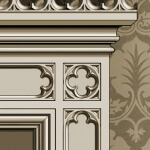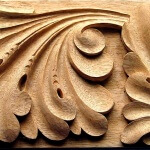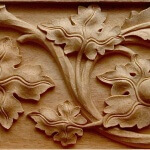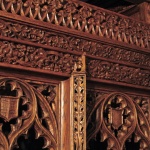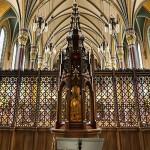With its origins in the Norman culture of France during the 12th century, the Gothic style quickly spread to other European countries. The woodcarving we reproduced on this page reflects the skill and vitality once achieved by the Gothic carvers. The flow, movement and crisp, clean lines explain why we never carve by machine. We prefer the traditional methods of carving by hand with a mallet and gouge.
The craftsmen of the time weren’t stifled by rhythm of the machine—the repeating beat that dominates our life today. They were free as individuals to create whatever detail they wanted within the overall plan laid out by the Master Carver. This gives Gothic decoration the charm and interest that we do not find in later styles and periods.
In addition to carved ornamentation, color played an important part in the Gothic period. Its use followed rules used in heraldry; blue, red, green, gold, and silver or white were employed in specific ways. Color adorned woodwork, ceilings and walls, and of course the breathtakingly beautiful stained-glass windows. Human figures and animals were a favorite theme, exaggerated and often portrayed by the carver in an entertaining and witty manner. We have all seen gargoyles, but the carved misericords found under the lifting seats in choir stalls across England and Europe capture wonderful images of life at the time with its humor, sins, home life and fantasies.
Decoration inspired by local flora developed over the Gothic period. In the 13th century, leaf motifs were less fanciful and portrayed simply. Later, they became more energetic. Eventually, in the late Gothic period, carved leaves became faithful copies of those seen in nature and were generally more heavily undercut. This muscular contrast of movement and flow created the wonderful effect of light and shade so prevalent in Gothic carving and sculpture.
Gothic woodcarving reached its peak at the end of the 15th century. However, we are lucky that many of the ceilings, rood screens, and choir stalls of English and European cathedrals and churches have remained intact. We can still appreciate the incredible craftsmanship and carving skills that the Gothic period gave us.
Check out designs for our historically accurate Gothic-style room.
- Detail: Gothic casing with carved tracery and cresting
- Gothic frieze woodcarving
- Carved wood panel in the German Gothic style
- Carved Gothic linenfold panel
- Carved wood Gothic capital based on a design found at Ely Cathedral
- Gothic screen woodcarving reproduction by Agrell Architectural Carving
- Gothic screen woodcarving reproduction by Agrell Architectural Carving
- A Gothic screen for the Cathedral of the Madeleine hand-carved by Agrell Architectural Carving
(Source: Handbook of Ornament by Franz Sales Meyer)


